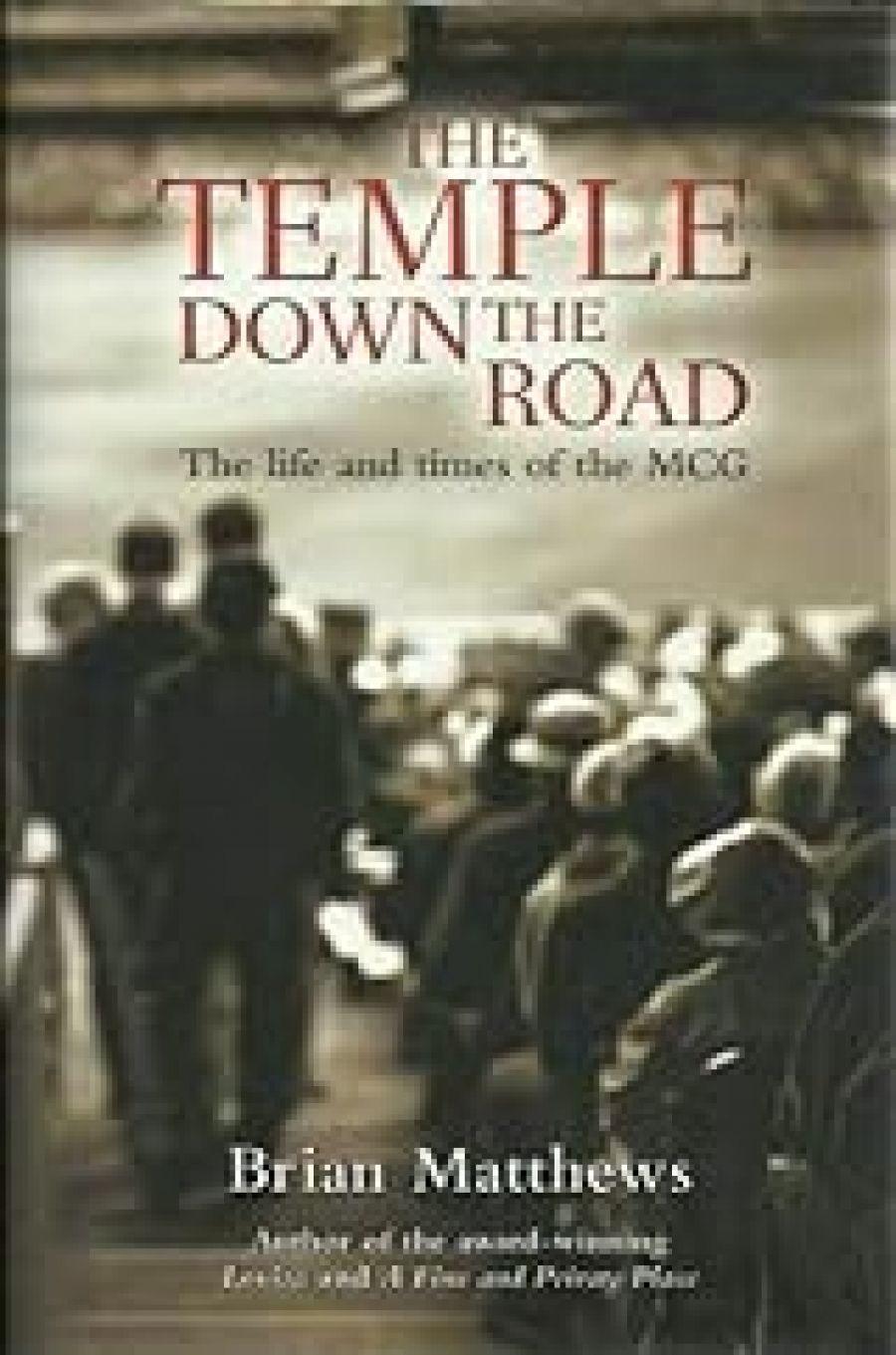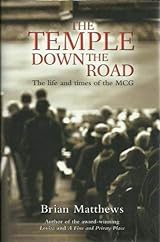
- Free Article: No
- Contents Category: Sport
- Custom Article Title: Memories of a Changing 'G'
- Review Article: Yes
- Article Title: Memories of a Changing 'G'
- Online Only: No
- Custom Highlight Text:
The Melbourne Cricket Ground was established on its present site in 1853. The first cricket match was played there the following year. It was a busy time in the early life of Melbourne: the University of Melbourne, the State Library of Victoria, the Royal Melbourne Philharmonic Society and The Age newspaper were all founded at this time. At a recent social gathering in Melbourne, someone asked which of these institutions was the most important and influential. Nobody hesitated in reply: it was the MCG, of course.
- Book 1 Title: The Temple Down the Road
- Book 1 Biblio: Viking, $39.95 hb, 322 pp
- Book 1 Cover Small (400 x 600):

- Book 1 Cover (800 x 1200):

The MCG is, after all, the birthplace of Test cricket and of Australian Rules football. It was the main stadium for the 1956 Olympic Games. In addition to hosting countless other big sporting events over its 150 years, it has been the site of many other major events: political rallies, royal tours, religious gatherings and rock concerts. The MCG has set so many national and international attendance records that one wonders if it is the ground itself, as much as any particular event, that is the drawcard. With justification, Matthews asserts that ‘the MCG is itself an event’.
The Temple down the Road belongs to a sports writing genre that has burgeoned over the last ten years: the view of the supporter in the stand. The English writers Nick Hornby and Tim Parks did it in their books about soccer fandom, Fever Pitch (1992) and A Season with Verona (2002), respectively. In Australia, John Harms and Martin Flanagan are our foremost exponents of the sports book that is part autobiography, part history and part social commentary. The great appeal of these writers lies in their ability to reflect, legitimise and analyse the ordinary person’s experience of what it feels like to be a fan. Matthews also writes in this vein.
Matthews’s love affair with the MCG is conducted from the outer. Not for him the private club manners of the Members’ Pavilion and the Long Room, or the boozy schmoozing of the corporate box. For Matthews, the authentic experience of the ‘G’ is to be found with the people in the public stands, and in the relationship of those people to the ground, to the event of the day, and to each other. This includes a discussion of the changing nature of the habitués of that part of the ground once designated Bay 13, which shifted over time from a favoured spot for serious cricket buffs to a rendezvous for yobbos. There is also a delightful digression into the history of queuing: ‘the essential idea of the queue was not originally to impose order but to defer gratification.’ The moral intention behind this suspension of desire was to make you a better person. As a St Kilda Football Club supporter, Matthews knows a lot about suspended desire.
Other digressions are less successful. Matthews tells us about his first visit to Venice, for instance. In order to justify the need to tell this story and then get us back to the MCG, he manufactures a clumsy segue. A description of the Church of Santa Maria della Salute – Our Lady of Health – leads to a passage about the development of Australian Rules as a way for cricketers to stay fit and healthy in winter. It’s a strained and tenuous link. Elsewhere, allusions to high culture are much closer to the mark. Matthews aptly captures the look and feel of a full house at the MCG for a big game: ‘the huge curve of the crowd around terraces and stands, like a pointillist painting full of sunlight.’
If you ask anyone who’s been to the MCG to describe their most vivid memory of the place, invariably what will be recalled is its size, the noise of the crowd and the heightened sense of occasion that each of these elements lends to whatever event is taking place on the oval. Yet, however hard-fought the contest, however intense the emotions of the spectators, this is a site of play. The mock-seriousness of it all means that the MCG can be a place of irony, as Matthews demonstrates in numerous stories about crowd humour. It also means that all the gritty confrontations that the ground has ever staged, in whatever sport, become ‘expressions of a society peaceful and unified enough to build, expand, value, patronise and stage spectacles at a stadium like the MCG’.
This is a timely book, not only to mark the sesquicentenary of the MCG, but also as there is a massive redevelopment of the stadium now underway. With more than half of the stands being knocked down to be replaced by modern facilities, aficionados are wondering if the place will be half as good after the transformation.
Many of the photographs in The Temple down the Road are by Megan Ponsford, granddaughter of the Australian (and Victorian) cricketer Bill Ponsford, after whom the now-demolished Ponsford Stand was named. The photographs are of the old parts of the ground, before the wreckers moved in. Often empty of people, these are intimate and melancholic images of a condemned place awaiting its fate. Megan Ponsford has also produced her own collection of MCG photographs, Home Ground (2003), published by Hardie Grant.


Comments powered by CComment